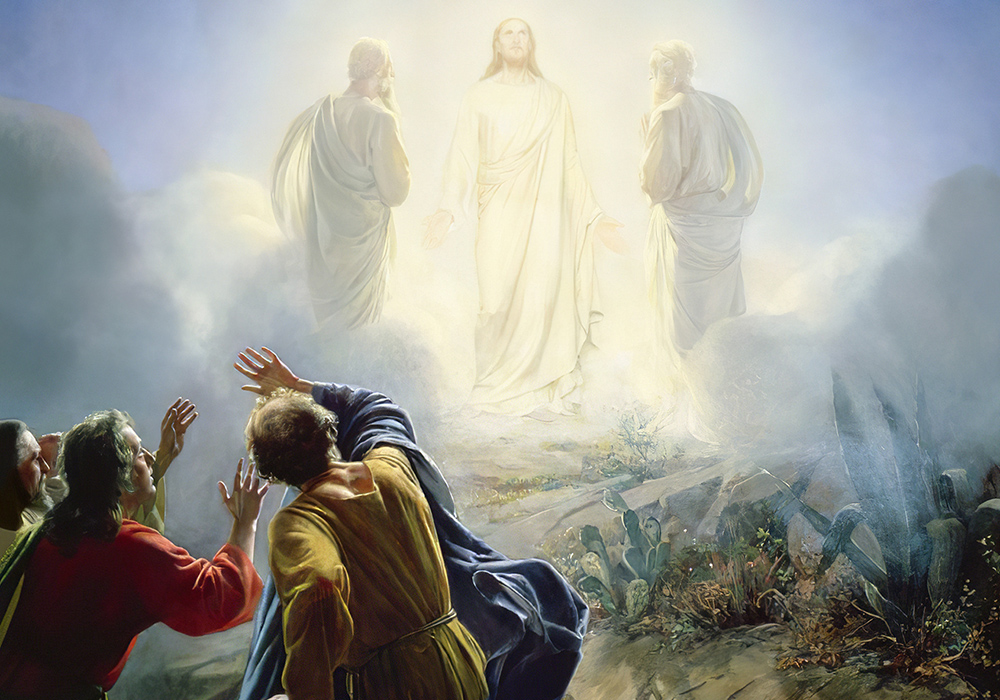
"Transfiguration of Jesus," 1872, by Carl Bloch (Artvee)
Did you ever wonder how the image of God as an elderly man with white hair got started? The Book of Daniel has probably inspired lots of artists, the most influential being Michelangelo. Interestingly, while a seeming majority depict God as European, Daniel suggests a more African image. Definitively gendered and ethnocentric religious art can cripple our imaginations.
To be fair, the author of today's first reading was not trying to say what God looks like in the description of the ancient one. The point of this passage was to assure a persecuted people that God outranked any earthly ruler and that God's kingdom would eventually triumph over all evil. The focus of this reading is the image of the son of man, leading us to contemplate Christ who used that title for himself (Matthew 16:27-28).
Son of Man is a mysterious term. Jesus used the term in at least three ways: as a simple description of his humanity, in reference to his upcoming passion, and finally anticipating his resurrected, eternal destiny. (For examples, see Matthew 8:20; 11:19; 16:13; 12:32; 17:22; and 17:9 and 25:31.) Son of Man seemed to be Jesus' preferred title, pointing to all he was and would be. Seeing this title as Jesus' description of his vocation prepares us to accompany him and the disciples up the mountain of the Transfiguration.
The Transfiguration scene echoes the Hebrew Scriptures at almost every turn. Most obviously, it features Moses, the one to whom God's law was revealed, and Elijah, the father of the prophets. Additionally, Jesus' ascent with two disciples evokes the memory of Moses leading his disciples to a mountain encounter with God (Exodus 24:9-11). Finally, and most strikingly, Matthew situates this incident six days after Jesus had spoken about his coming passion. That seemingly subtle detail situated the Transfiguration on the seventh day, referring to the fulfillment of creation (Matthew 17:1, Genesis 2:1-3). Matthew gives us these details as if they were background music to what is about to happen — even if the disciples weren't aware of it. (Imagine "How Great Thou Art.")
Jesus' disciples were probably not expecting much to happen on that mountain. They had been with Jesus and seen him pray before. But this time was different. Without any preamble, Jesus became transfigured (metamorphized) before them. Matthew tells us that Jesus' garments were white as light and his face shone like the sun. Symbolically, the light, the first thing God created, indicates that Jesus was clothed in God's presence. Jesus' shining face suggests something more.
The Hebrew word for praise is tehillah, which means to shine, indicating that a prayer of praise leads one to reflect the glory of God. Jesus' shining face revealed God. His prayer made him a mirror of God. Standing with Moses, God's lawgiver, and Elijah the prophet, Jesus reflected God's glory. This underlines Matthew's theology of Jesus as Emmanuel, God in our midst. (See Matthew 1:23 and 28:20.)
Advertisement
Peter embodied the disciples' response to this epiphany. They were glimpsing something more than they had previously perceived about Jesus and, like people concentrating on cameras at a wedding, their first response was to freeze it in time rather than let it affect them in the moment. Suddenly they were swept beyond their wonder and enveloped in a cloud, a sign that there was more to this moment than they could grasp.
Beyond the symbolism of Moses and Elijah, the mountain and the light, the crux of the experience was the word of God: "This is my beloved Son … listen to him." That proclamation, echoing what Jesus had heard at his baptism (Matthew 3:16-17), confirmed Jesus as God's own and voiced the one command necessary: "Listen to him."
"Listen to him." That's all. If we want to know what God is like, listen to him. If we want to hear God's voice in our own time, if we want to know the will of God, listen to him.
Hidden in that command is the invitation to praise him — for what else would we do if we really recognize him? Then, like Jesus before God, our praise will begin to transform us into his image.
The wonder of the Transfiguration was not a light show but an invitation. If we want to know what God really looks like, we will gaze on those who love God — they come with curly hair and gray buns. They're old and young, Christian, Muslim, Jew and more. Not even Michelangelo could imagine all the variations in which God chooses to appear among us.
Just listen and our world will be transfigured.
